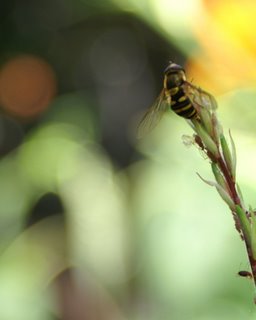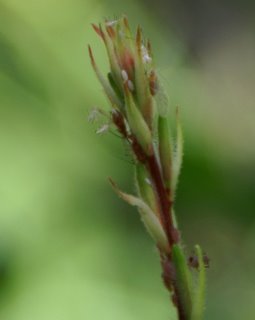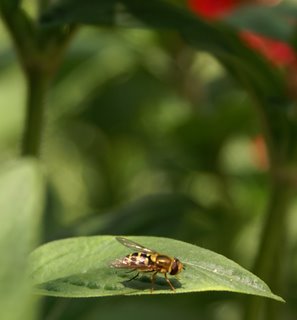 Where there are aphids, there will be syrphid flies if you let nature take its course. If you spray non-targeted insecticides at the first sign of an aphid, you will likely kill whatever syrphids are around and will miss seeing a really neat thing.
Where there are aphids, there will be syrphid flies if you let nature take its course. If you spray non-targeted insecticides at the first sign of an aphid, you will likely kill whatever syrphids are around and will miss seeing a really neat thing. 
This fly located a rich field of aphids on these budding gaura lindheimeri flower stalks. I mean, these plants were literally dripping with aphids which were dropping off wholesale in response to my messing with their flower stalk. I always wonder how long it takes 'em to climb back to the top where they like to feed. Anyway, it's the smell of a happy, productive aphid colony that guides the female syrphid fly to good aphidy spots to lay her eggs.

The eggs hatch in a few days to what I guess technically is a maggot, seeing as it is a fly larva. These maggots are kind of pretty and live to devour aphids. Four days after this larva was photographed amid a robu
 st aphid colony, virtually all healthy aphids were removed from that stalk. It's likely that some of the aphids dropped or walked off in response to the syrphid larva's predation on their siblings; the maggot did not eat all those aphids. But this disruption in the aphid's colonization is sure to weaken the individual aphids making them more susceptible to further predation and parasitism. In the meanwhile, the plant is rid of them. Support your local syrphids and take back the stalks!
st aphid colony, virtually all healthy aphids were removed from that stalk. It's likely that some of the aphids dropped or walked off in response to the syrphid larva's predation on their siblings; the maggot did not eat all those aphids. But this disruption in the aphid's colonization is sure to weaken the individual aphids making them more susceptible to further predation and parasitism. In the meanwhile, the plant is rid of them. Support your local syrphids and take back the stalks! Syrphid flies mimic the appearance of bees as a protective strategy. They differ from bees in many ways, not the most mundane of which is their ability to hover in place. On a good day, with the sun pouring down like aphid-scented honey, you'll see lots of them stationed around your flowers like geosynchronous satellites, occasionally darting off on a fly mission, or settling to feed, or maybe rest.

No comments:
Post a Comment